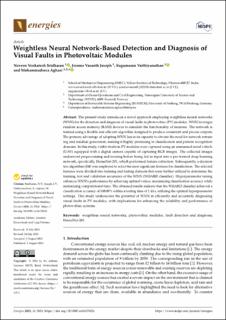| dc.contributor.author | Sridharan, Naveen Venkatesh | |
| dc.contributor.author | Joseph, Jerome Vasanth | |
| dc.contributor.author | Vaithiyanathan, Sugumaran | |
| dc.contributor.author | Aghaei, Mohammadreza | |
| dc.date.accessioned | 2023-11-03T08:25:48Z | |
| dc.date.available | 2023-11-03T08:25:48Z | |
| dc.date.created | 2023-09-01T11:54:23Z | |
| dc.date.issued | 2023 | |
| dc.identifier.citation | Energies. 2023, 16 (15), . | en_US |
| dc.identifier.issn | 1996-1073 | |
| dc.identifier.uri | https://hdl.handle.net/11250/3100406 | |
| dc.description.abstract | The present study introduces a novel approach employing weightless neural networks (WNN) for the detection and diagnosis of visual faults in photovoltaic (PV) modules. WNN leverages random access memory (RAM) devices to simulate the functionality of neurons. The network is trained using a flexible and efficient algorithm designed to produce consistent and precise outputs. The primary advantage of adopting WNN lies in its capacity to obviate the need for network retraining and residual generation, making it highly promising in classification and pattern recognition domains. In this study, visible faults in PV modules were captured using an unmanned aerial vehicle (UAV) equipped with a digital camera capable of capturing RGB images. The collected images underwent preprocessing and resizing before being fed as input into a pre-trained deep learning network, specifically, DenseNet-201, which performed feature extraction. Subsequently, a decision tree algorithm (J48) was employed to select the most significant features for classification. The selected features were divided into training and testing datasets that were further utilized to determine the training, test and validation accuracies of the WNN (WiSARD classifier). Hyperparameter tuning enhances WNN’s performance by achieving optimal values, maximizing classification accuracy while minimizing computational time. The obtained results indicate that the WiSARD classifier achieved a classification accuracy of 100.00% within a testing time of 1.44 s, utilizing the optimal hyperparameter settings. This study underscores the potential of WNN in efficiently and accurately diagnosing visual faults in PV modules, with implications for enhancing the reliability and performance of photovoltaic systems. | en_US |
| dc.language.iso | eng | en_US |
| dc.publisher | MDPI | en_US |
| dc.rights | Navngivelse 4.0 Internasjonal | * |
| dc.rights.uri | http://creativecommons.org/licenses/by/4.0/deed.no | * |
| dc.title | Weightless Neural Network-Based Detection and Diagnosis of Visual Faults in Photovoltaic Modules | en_US |
| dc.title.alternative | Weightless Neural Network-Based Detection and Diagnosis of Visual Faults in Photovoltaic Modules | en_US |
| dc.type | Peer reviewed | en_US |
| dc.type | Journal article | en_US |
| dc.description.version | publishedVersion | en_US |
| dc.source.pagenumber | 0 | en_US |
| dc.source.volume | 16 | en_US |
| dc.source.journal | Energies | en_US |
| dc.source.issue | 15 | en_US |
| dc.identifier.doi | 10.3390/en16155824 | |
| dc.identifier.cristin | 2171624 | |
| cristin.ispublished | true | |
| cristin.fulltext | original | |
| cristin.qualitycode | 1 | |

